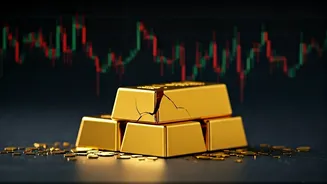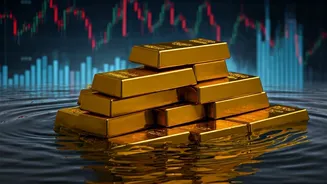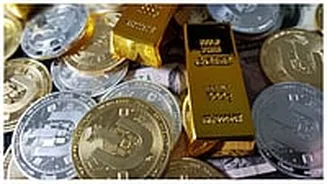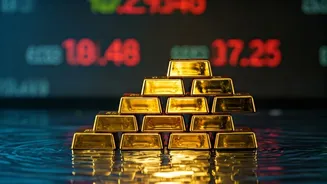Dollar's Influence on Gold
The relationship between the U.S. dollar and gold is often described as an inverse one, wherein when the dollar strengthens, gold prices tend to weaken,
and vice versa. Recently, the dollar has shown signs of gaining strength. This could be due to several factors, including positive economic data releases or shifts in investor preference towards the dollar as a safe-haven asset. Moreover, the Federal Reserve's monetary policy, including interest rate decisions and future policy outlooks, also greatly influences the dollar's value. When interest rates rise, the dollar usually becomes more attractive to investors, which in turn could encourage investors to move their funds from gold to dollar-denominated assets. This shift affects gold prices by decreasing its demand in the market, pushing the price down. Conversely, a weak dollar often makes gold more appealing to investors, leading to increased demand and rising prices. Investors continuously monitor the dollar's performance, as its strength or weakness can profoundly impact the direction of gold prices, as was observed during this recent correction.
Market Sentiment Changes
Market sentiment, the general attitude or feeling of investors towards an asset, plays a significant role in gold price movements. A shift in this sentiment can significantly influence gold’s price direction. For instance, positive economic indicators or increased risk appetite among investors can lead to decreased demand for safe-haven assets like gold. If investors feel more confident in the economy and seek higher returns from riskier assets like stocks, this reduces gold’s allure as a secure investment. Conversely, if economic uncertainties or geopolitical risks increase, investors often turn to gold as a safe haven, boosting its price. The recent correction in gold prices might indicate a shift from this safe-haven investment towards other options. Understanding this interplay is essential to interpreting the market dynamics of gold and forecasting its price fluctuations. Changes in investor sentiment, whether driven by economic updates, political events, or market trends, frequently trigger significant shifts in gold prices, as recent trends have demonstrated.
Interest Rate Impact
Interest rate decisions by the Federal Reserve and other central banks significantly influence gold prices. When interest rates increase, it boosts the opportunity cost of holding non-yielding assets like gold, potentially decreasing demand. Investors often shift funds from gold to assets that offer higher returns due to increased rates. Higher interest rates typically strengthen the dollar, which can further depress gold prices, as mentioned previously. Conversely, when rates are lowered, the appeal of gold may rise. Moreover, the expectations surrounding future rate changes are just as crucial. Any indications of potential policy shifts can cause short-term market reactions, leading to price volatility. Market participants keenly watch these announcements and the subsequent economic repercussions for their investment strategies. This ongoing interaction between monetary policy and gold prices helps to shape its price trajectory and investors' decisions.
Global Economic Indicators
Economic data from various countries and regions significantly affects gold's value. Positive economic reports, like robust GDP growth or low unemployment rates, may reduce demand for safe-haven assets such as gold, leading to price corrections. Conversely, any economic slowdown or fears of recession often stimulate demand for gold, pushing prices upward. These economic indicators give clues about the overall health of the global economy and offer insights into market behavior. For instance, data from major economies such as the U.S., China, and the Eurozone are constantly evaluated by investors when making decisions about gold. Inflation rates also play an important role; high inflation often spurs demand for gold as a hedge against the diminishing value of fiat currencies. Examining these global economic indicators allows investors to anticipate market trends, helping them make more informed trading decisions, with recent events reflecting these dynamic shifts.
Geopolitical Factors & Gold
Geopolitical events can significantly influence gold prices, often leading to increased demand during times of uncertainty. Conflicts, political instability, and any potential escalations in global tensions typically lead investors to seek safe-haven assets like gold. These events create uncertainty in the markets, pushing investors towards gold to protect their capital. Any major geopolitical event, such as a war or political crisis, can result in rapid price increases. Also, the level of perceived risk within the global environment can also drive market behavior. When the likelihood of major conflicts or economic disruption rises, investors typically increase their holdings of gold. Additionally, changes in political alliances or shifts in global power dynamics can affect gold prices. These dynamics make gold a valuable asset for investors seeking stability during turbulent times. The recent movements in gold prices reflect how geopolitical risks continuously shape the precious metal's market.














